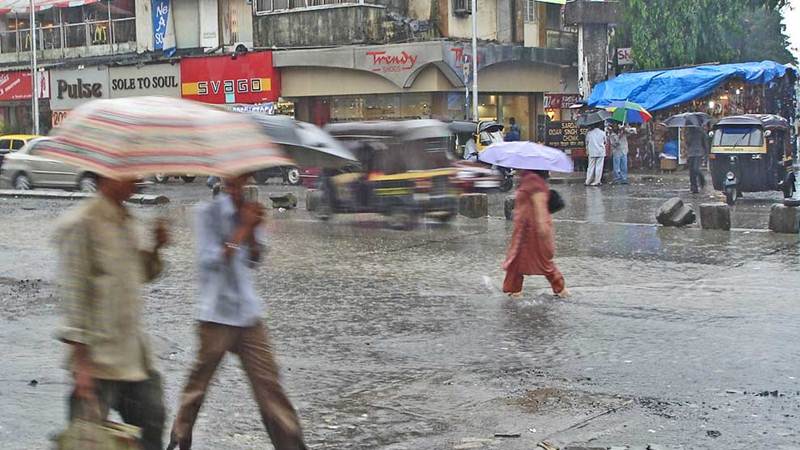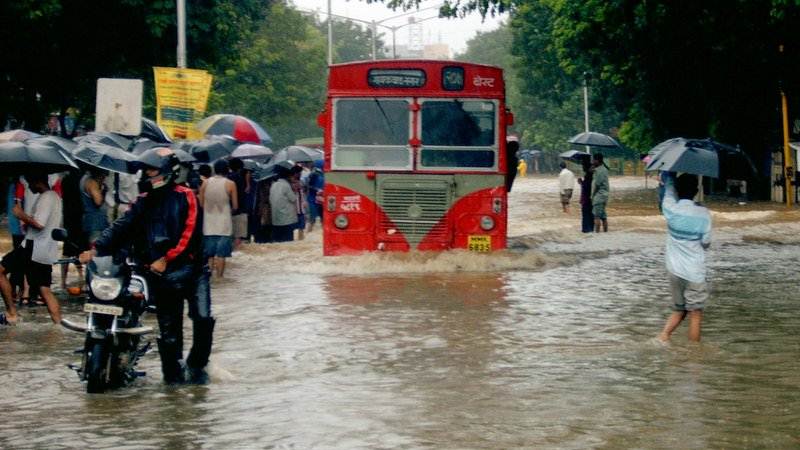Mumbai Rains: Why is the city battered by heavy rainfall? What explains the severe weather, likely till June 14?
Monsoon systems prevailing on either side of the coast — the Arabian Sea and the Bay of Bengal — tend to interact with each other, bringing widespread rainfall. This is known as the ‘dumbbell effect’ and is causing the rains in Mumbai and parts of Maharashtra.


Multiple studies claim that coastal cities such as Mumbai and Kolkata face the severest threats from climate-induced flooding. Photo: Twitter/ @ashish_thewolf
The India Meteorological Department (IMD) has issued a severe weather warning for parts of Maharashtra, including Mumbai, and heavy rainfall is expected to lash the state for three days till June 14.
The southwest monsoon arrived in Mumbai on June 9, and the city has been witnessing heavy downpour and flooding. On the night of June 9, a building collapsed in Malad, killing 12 people, including eight children.
The Bombay High Court has ordered a judicial inquiry into the Malad building collapse. Almost every year during the monsoon season, there are incidents of building collapse in the Mumbai Metropolitan Region (MMR).

Also Read: Rock and ice avalanche caused Feb 2021 Chamoli, Uttarakhand disaster, explains scientific study
“A cyclonic circulation is marked over east-central and adjoining Northeast Bay of Bengal. The weather system is expected to organise and deepen into a low-pressure area by tonight [June 11],” explained GP Sharma, President-Meteorology and Climate Change at Skymet Weather, a private weather agency.
In the subsequent 24 hours, the low pressure area is likely to intensify further into a well-marked low or depression over the head of Bay of Bengal, said Sharma. The head covers parts of Odisha and West Bengal in India as well as Bangladesh.
“Monsoon systems prevailing on either side of the coast tend to interact with each other, bringing widespread rainfall. This is known as the ‘dumbbell effect’. We can expect active to vigorous monsoon conditions from June 11 to June 15,” he added.

The western arm of the monsoon over the Arabian Sea will strengthen “to lash the entire West Coast, including Kerala, Karnataka, Goa and Konkan, with heavy to very heavy rains between June 9 and June 16. The severe flooding situation will quite likely be in and around Mumbai between June 13 and 15,” added Sharma.
Warm oceans, intense weather events
While there is no direct correlation between the heavy rainfall in MMR and climate change, meteorologists and weather experts have been warning that with the onset of the monsoon, there is plenty of moisture available in the atmosphere. And because the sea surface temperatures are still very warm, this fuels the formation of intense weather systems in the Indian basins.
“The ocean and atmospheric conditions are still very much conducive for weather systems to intensify. Though there has been some sea surface cooling post the cyclones, the ocean continues to be warm, with temperatures hovering around 30°C and over,” informed Roxy Mathew Koll, climate scientist at the Indian Institute of Tropical Meteorology, Pune.
“These warm sea surface temperatures and low vertical wind shear are conducive for a low-pressure system to form and intensify over the north Bay of Bengal, but not a cyclonic storm. The Arabian Sea is also warm and moist, so the monsoon winds may carry more moisture as it gets pulled inland and strengthens in response to the low-pressure system in the Bay,” explained Koll.
He also informed that their research shows there is an increasing trend in these kinds of events, resulting in heavy rains over the west coast and central India.
Also Read: Uttarakhand: The Himalayan state is besieged by extreme floods and increased droughts
Extreme weather events, floods and losses
Increasing extreme weather events are leading to heavy losses in India. Multiple studies claim that coastal cities such as Mumbai and Kolkata face the severest threats from climate-induced flooding.
According to a report by the Ministry of Earth Sciences, Government of India, ‘Assessment of Climate Change over the Indian Region’, published in June 2020, Mumbai region is highly vulnerable to climate change due to sea-level rise, storm surge and extreme precipitation. During the last 20 years, Mumbai has already seen massive flood events in 2005, 2014, 2017.
A recent assessment of satellite imagery of the Mumbai, Navi Mumbai, Thane, and parts of Konkan coast in Maharashtra shows how fast coastal lands are being lost to the rising sea-levels and increasing urban flooding.
Also Read: Mumbai Metropolitan Region has lost land worth 15,000 football fields in past 30 years: Study
Srushti Conservation Foundation (SCF), a Pune-based non-profit organisation, has conducted a satellite study which shows that in the past three decades, MMR has lost about 107.6 square kilometers of its coastal area, including agricultural land, due to the rising sea-level. The area lost equals over 15,000 football fields.
Unplanned development and rapid construction in ecologically sensitive areas such as mudflats and mangroves have compounded the risks of climate change-induced flooding.
“As we are seeing now with the Tauktae and Yaas cyclones, low-income and other marginalised groups are most vulnerable to the impacts of climate change. They often live in dense settlements that lack basic services and infrastructure which could reduce risk,” said Amir Bazaz, Senior Lead-Practice at the Indian Institute for Human Settlements.
“Many households also live on hazardous sites such as steep slopes and floodplains. It is therefore crucial to bring climate and development goals together,” he added.

